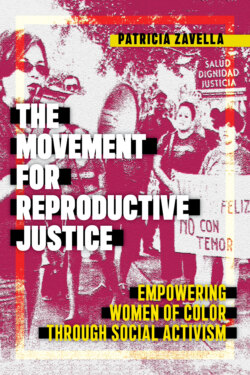The Movement for Reproductive Justice

Реклама. ООО «ЛитРес», ИНН: 7719571260.
Оглавление
Patricia Zavella. The Movement for Reproductive Justice
CONTENTS
ABBREVIATIONS
PREFACE
Introduction
The Movement for Reproductive Justice
The Praxis of Intersectionality
The Human Right to Health
My Research
Overview of the Book
1. Culture Shift Work
Theorizing Culture Shift
Voicing Our Power: Soy Poderosa
Voicing Our Power: Somos Chingonas
The Strong Families Network
Contesting Teen Pregnancy Prevention
Black Mamas Matter
Conclusion
2. Collaborating across Difference
Cross-Sectoral or Intersectional Collaboration
Leadership Development in Texas
Building Capacity in California
Conclusion
3. Youth Mobilization
Forward Together’s “Sex Ed the City” Campaign
ICAH’s Work Contesting Parental Notification of Abortion
COLOR’s Youth Programs
Conclusion
4. From Self-Care to Healing Justice
Healing Multigenerational Trauma
Forward Stance
COLOR’s Culture of Appreciation and Resiliency
Young Women United Guided by Spirit
Conclusion
Conclusion
Reproductive Justice Advocates Respond to the Trump Political Regime
Empowering Women through Reproductive Justice Advocacy
ACKNOWLEDGMENTS
APPENDIX
NOTES. PREFACE
INTRODUCTION
CHAPTER 1. CULTURE SHIFT WORK
CHAPTER 2. COLLABORATING ACROSS DIFFERENCE
CHAPTER 3. YOUTH MOBILIZATION
CHAPTER 4. FROM SELF-CARE TO HEALING JUSTICE
CONCLUSION
APPENDIX
REFERENCES
INDEX
ABOUT THE AUTHOR
Отрывок из книги
THE MOVEMENT FOR REPRODUCTIVE JUSTICE
General Editor: Ida Susser
.....
It is vital to consider the importance of place and focus on organizations that include the perspectives of those who are multiply marginalized by institutions, women of color with low incomes like Lola.109 I analyze how women of color in reproductive justice organizations contest structural processes of power within particular contexts in relation to one another and simultaneously see activism on behalf of women as integral to the well-being of all.110 I also illustrate how women of color construct political strategies and identities while attempting to end reproductive injustice.
The notion that those who are marginalized by society in the United States deserve human rights and that these rights were linked to the Declaration of Independence and the Constitution was first articulated by the social reformer Frederick Douglass in the 1850s. He also argued that access to economic, social, and cultural rights should accompany human rights.111 Yet it was not until the post–World War II era that the United Nations issued guidelines for government activity related to human rights.112 The Constitution of the World Health Organization declared in 1946 that the right to health includes public health, sanitation, occupational and environmental conditions, education and nutrition, and medical treatment provided in a nondiscriminatory manner, expressing the idea that human rights are inextricably intertwined.113 Women have pushed for the notion that “women’s rights are human rights,” a slogan first used at the UN World Conference on Human Rights in Vienna in 1993. The United States ratified three international human rights treaties that protect women’s reproductive rights: the International Covenant on Civil and Political Rights, the International Convention on the Ratification of All Forms of Racial Discrimination, and the Convention against Torture. The United States also signed the Convention on the Elimination of All Forms of Discrimination against Women and the International Covenant on Economic, Social, and Cultural Rights, which confer important reproductive rights such as the right to health.114 However, there is no right to be healthy under international or national law.115 The right to health care is not mentioned in the US Constitution, and states are not required to pay medical expenses of indigents, though most provide some health coverage for the elderly and people with disabilities.116 Nonetheless, the World Health Organization’s definition of optimal health care was a critical intervention, a “step toward denaturalizing the suffering produced by social causes.”117
.....